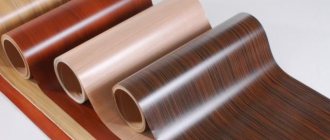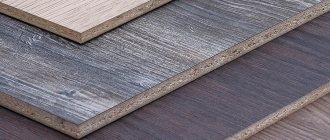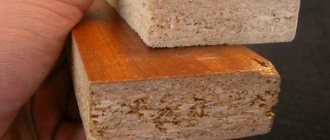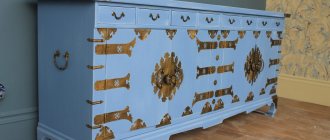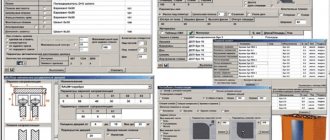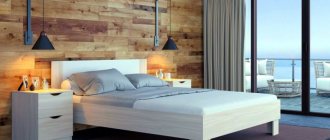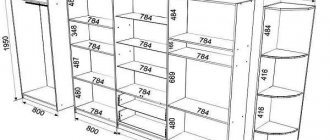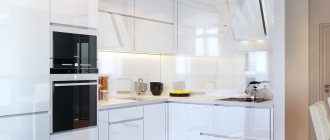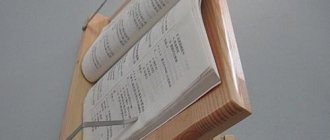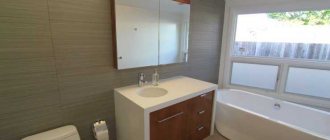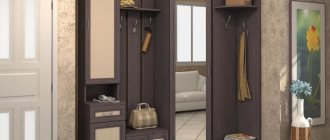What is chipboard lamination and how to laminate furniture at home: Review + Video
Furniture lamination is the process of applying a special film or paper to the material, after which its appearance becomes more expensive and elegant. Furniture made from chipboard is subject to lamination - a cheap and therefore in-demand building material that is quite durable, but does not look very presentable. It allows you to make repairs economically, and laminating furniture at home will smooth out all the shortcomings of the slab and will be a practical, non-wasteful solution.
How to laminate chipboard at home?
Share on social media networks:
- Features of obtaining laminated chipboard
- Do-it-yourself methods for laminating chipboard
- How to laminate chipboard at home: laminating technology
- Selecting lamination film
- Video material
Chipboard is one of the most inexpensive materials, which is still not abandoned in the manufacture of furniture. In general, with proper design, interior items look like a worthy imitation of natural wood and add their own flavor to the overall style. But ordinary chipboard is not suitable for this purpose. The plate looks unpresentable. In addition, there is a risk of getting splinters if you carelessly touch the edge. About 40 years ago, a technology for producing decorative surfaces using lamination was developed. Let's take a closer look at how to laminate chipboard with your own hands at home.
Main questions
What is "chipboard"?
Chipboard stands for “chipboard.” From the name you can understand that this is not a separate type of wood, but a mixture of wood shavings, held together with glue and placed under a press. This material is inexpensive and is used instead of scarce wood, it is easy to work with and durable, which is what arouses interest. Thanks to modern decorating techniques, chipboard will become a worthy replacement for expensive wood, the extraction of which, moreover, causes enormous harm to our environment.
ADVICE! Laminated chipboard can be immediately purchased at the factory, it can be made to order, but you can independently process a regular pressed board using laminating agents.
Why laminate chipboard?
Looking at a product made from chipboard, it becomes clear why it is recommended to laminate the raw material. Firstly, it does not look very beautiful, its decorative qualities leave much to be desired. Secondly, lamination will smooth the surface, make it more pleasant to the touch and help avoid the danger of splinters, scratches or snags on thin fabric. Thirdly, the procedure will significantly improve the quality of the product, making it more moisture resistant, which is very useful for kitchen furniture.
How to laminate chipboard with your own hands
Process
Laminating chipboard at home involves applying a special film to the surface.
ATTENTION! It is impossible to reproduce the perfect finishing of furniture at home. Factories immediately produce furniture made from laminated chipboard (chipboard), the quality of which will be better and the service life will be longer, with the remaining savings.
There are several ways to laminate furniture at home:
- — Application of self-adhesive film to the surface. Simply remove the layer of protective paper and carefully apply it to the furniture. After the film has stuck, remove air bubbles with a plastic spatula or cloth.
- — Gluing the film with glue. Universal adhesive is applied to the slab and left for a while, after which a film is applied to it. For high-quality gluing, it is recommended to roll it over and hold it under pressure.
BE CAREFUL! When applying the film, carefully measure the shape and surface area, because if you apply the laminate material crookedly, it will be impossible to reuse it - re-glue it.
Which laminating film should I choose?
For lamination of chipboards, several types of films have been developed, which differ in their properties, composition and cost:
- — Phenolic film. Its properties include increasing the wear resistance of materials in terms of mechanical damage, but also having a low moisture resistance.
- — PVC (Polyvinyl chloride). The functionality of this film is aimed at improving the water resistance of furniture.
- — Melamine film. Its properties include wear resistance and moisture resistance, however, the membrane contains formaldehyde resin, which can cause some damage to health when heated. This product should be used outdoors. Cooled material is not hazardous.
Preparation for lamination
Before applying film to furniture, you need to prepare it for the procedure:
1) First we sand the product. This can also be done with sandpaper - if it is not large in size, or, if it is large in size - with a grinder. Sand until the furniture walls are smooth.
2) Then it is recommended to putty the chipboard, dry it and go over it again with less sandpaper.
IMPORTANT! The smoother the surface, the more accurately the film will sit.
3) Next, the workpiece is treated with a wood primer and dried.
4) It is necessary to cut the film, adjusting it according to the details - take into account the height, width, shape and corners of the furniture.
5) Next, proceed to gluing the film: having freed part of the protective layer, apply it to the surface of the furniture and gradually move along it.
How are chipboards made?
To make laminated chipboards, ordinary sanded chipboards are used, so they are produced at a chipboard production plant, connecting a lamination section .
Moreover, 3 technologies are used to cover the source material with a laminating film:
- lamination;
- laminating;
- smooth lamination.
Lamination
When laminating, 1-2 layers of specially prepared paper are glued onto the base , and the first layer - the base - is made as thick as possible so that the design can be pressed into it.
The thickness of the base, depending on the depth of the pattern, can reach 0.5–1 mm, the thickness of the second layer is tenths or even hundredths of a mm.
On top of these layers, another one is laid, made of transparent paper and a mixture of various resins, which, when heated, turn into a durable film that reliably protects the decorative surface.
The base layer is laid on the prepared chipboard surface and pressed down with a hot stamp with a suitable pattern.
The surface temperature of the stamp is 150–220 degrees, due to which the resin that impregnates the base layer is mixed with the resin that glues the chips in the chipboard and the paper becomes an inseparable part of the board .
Then, in the same way, a decorative layer with a suitable pattern and an outer layer are glued, which protects the slab from damage.
At some enterprises, all layers of coating are first connected to each other, then dried and, only after that, attached to the chipboard.
With this technology, the coating is made in the form of a tape. The pattern on it is formed using a cylinder with an installed matrix, similar to the formation of a pattern during laminating.
The difference with laminating is that the tape is attached without glue, heating the resins that impregnate the paper until it melts and mixes with the resin in the chipboard.
Laminating
When laminating, the facing material is first prepared, for which all layers are laid in order and a pattern is printed on them using a cold press .
At the same time, the uncured resin of the various layers is mixed, due to which the coating turns into a wide and long ribbon.
If a cylindrical stamp , then it becomes possible to make ribbons of any length .
Many small enterprises producing laminate with a three-dimensional texture prefer not to spend money on expensive equipment necessary for the production of tape, but to buy ready-made material.
The finished tape is sent to the dryer, then wound into rolls, which are delivered to the laminating area. There, the facing material is cut to size and placed on a slab coated with a special glue, then pressed with a press and heated until the glue is completely polymerized.
Thanks to this technology cladding goes faster , because there is no need to heat each layer of coating separately , so the enterprise can produce more products.
The disadvantage of this technology is that the glued cladding holds much weaker than real lamination.
Smooth lamination
This technology is similar to laminating , but is a full-fledged lamination, because when heated, the resin of the coating and the boards are mixed, forming a single material. In addition, there is no press for creating a pattern .
To create a smooth surface, it is enough to lay 2 layers, the bottom of which will be made of paper , and the top of a special film, which, when heated, forms a durable and transparent coating .
Due to the fact that large chipboard manufacturers are constantly looking for ways to increase production manufacturability and reduce costs, various changes are constantly being made to this process, the essence of which is kept secret by manufacturers. After all, any improvement in the quality of the laminating coating, as well as a reduction in costs, makes their products more competitive.
Other methods of processing furniture
In addition to simply applying film to glue or gluing self-adhesive tape, there are several other methods for processing chipboard furniture:
- — Laminating. In this method, glue is applied to the product, and then a thermal film of a polymer composition is applied.
- — Veneering. Veneer is a very thin layer of high-quality wood, if natural, if synthetic - paper canvas with imitation of wood patterns. Using molten resins, such material is welded to the base under the influence of high temperatures.
Thus, laminating furniture at home is quite easy and the quality depends solely on your efforts.
What is chipboard? Features of the technology
Cabinets, cabinets, kitchen sets of middle and economy classes are made from chipboards that have undergone the stage of surface lamination with decorative and protective materials at the factory. These are the so-called chipboards.
The variety of colors and textures of laminated chipboard is amazing
Cladding is one of the final stages of chipboard manufacturing. This uses:
- paper film impregnated with thermosetting synthetic resins;
- laminated paper plastic containing impregnating resin compositions.
For the production of laminated chipboards, short-cycle or conveyor belt presses are used. At temperatures up to 250°C and under the influence of a pressure of 25-30 MPa (25-30 kg/cm 2 ), a physical and chemical process occurs: the resin seems to spread over the surface, seals it and forms a durable single canvas.
The production capacities of large factories make it possible to achieve a complete imitation of the texture of wood, stone, fabric, etc. Often, for individual collections of furniture or decorative finishing works, slabs with gloss, embossing, varnished or with a 3D effect are produced.
Lamination is often understood as another process - lamination. The technologies are similar, the difference is in the fastening composition. If in the first case synthetic resins are first melted and then pressed, then in the second case gluing is used. An adhesive composition is applied to the base plate, then a thermoplastic polymer film or hardened laminate is applied and rolled. This type of coating is weaker to tear off and can swell and get wet. A laminated board is actually a single whole and practically cannot be divided into components.
The next process, similar to lamination, is veneering. Veneer is a thin section of valuable wood with a thickness of at least 2 mm. Glued with special one- or two-component adhesive compounds, the surface turns out beautiful and unique, since there are no two identical layers of wood, and it is this fact that adds attractiveness and beauty to the veneer. The coating requires care and protection from moisture and mechanical damage. HDSP can be painted, varnished, waxed, oiled or impregnated. When peeling off elements, it is recommended to use carpentry or universal adhesives.
Marketers have coined a new term - synthetic veneer. A sheet of textured paper with a decor that imitates wood pores is impregnated with urea resins and dried. Often the surface is varnished. The resulting material is called synthetic veneer, and is glued to the surface of the chipboard under pressure and at high temperature. The coating turns out to be quite hard, dense, identical to natural veneer even to the touch.
Thus, lamination is the process of “welding” paper with decor using a melt of synthetic resins. This is the most reliable and durable method of cladding chipboard. The surface is durable, resistant to elevated temperatures and water, and mechanical damage.
How is laminated chipboard made?
Laminated particle boards are common products that have been lined with a decorative coating. It can be plain and smooth, multi-colored, or imitate the texture of wood. This improved material is produced at those factories where conventional chipboards are made. This is possible at enterprises where the lamination line was launched.
Three technologies are used for coating conventional chipboards: lamination, lamination and smooth lamination. To understand the difference between the methods, they need to be considered in detail.
Lamination
In this operation, first 2 layers of special paper are glued onto the base. The first of them is made as thick as possible in order to be able to push through the design in the future. The thickness of this layer can be either 0.5 or 1 mm. The second, decorative one, is much thinner: its thickness is only tenths or hundredths of a millimeter.
Another layer is laid on them. It consists of transparent paper and resins, which, when heated, become the most durable film that protects the decorative surface of the slab from damage. All operations are carried out sequentially:
- First, a thick base layer is laid on the chipboard, then it is pressed down with a hot stamp having some kind of pattern. Its surface temperature is 150-220°. Thanks to it, chipboard and paper become one.
- Then, in a similar way, a decorative layer with a certain pattern is glued (pressed, heated), followed by a protective one. The result is durable protection that becomes an integral part of the slab.
This is the first option. At some enterprises, lamination technology is different. First, all layers of the coating are joined together, then the resulting film is dried, then glued to the plate with a hot press. This covering is tape. To apply the pattern, a cylinder is used, on which the matrix is installed.
Laminating
The steps in this process vary by manufacturer. Some factories have their own workshops (lines) for laminating. Others, for reasons of economy, prefer not to spend money on purchasing additional, expensive equipment for the production of coatings. They buy materials made by others. In general, laminating is the pressing of finished (roll) film onto chipboard using glue.
This operation differs from lamination in the absence of high temperature. All layers of the future coating are laid in order, and then connected, the design is printed using a warm (hot, cold) press. The resin layers are mixed to form a tape of durable film.
The finished product is sent to the dryer; after drying, the film is wound into rolls and transported to the laminating area. Here the coating is cut to the size of the slabs. A special glue is applied to the chipboard sheets, a film is laid on top, and heated with a press until both elements become one.
This technology makes it possible to avoid wasted time, since the coating does not have to be heated layer by layer. Thus, the plant is able to produce more products. But the downside is also significant: such cladding may hold up worse than something made using lamination technology.
The main difference between lamination and lamination is softer, more gentle production conditions: the former uses lower temperatures and pressure. The difference in temperature conditions and technologies in particular is the reason for the higher cost of laminated products.
Smooth lamination
This method is similar to lamination, but it is true lamination, since there is one difference from it: due to the lack of relief on the products, a stamp is not used. To create a smooth lamination, “only” 2 layers are laid on the chipboard. The first is traditional (thick) paper, the second is made of protective film paper. As in the lamination process, both layers are pressed separately (sequentially) and heated at high temperature.
Which is better: lamination or laminating?
To understand the difference between them, you need to understand what the features of both technologies are. The use of ready-made film is not the only difference between laminating. A brief description of the methods and a few numbers is enough.
- Lamination is a physical and chemical process of lining with paper-resin films. Temperature - 150-220°, pressure - 25-28 MPa.
- Laminating is a physical process of lining with finished paper-resin films using an adhesive composition. Temperature - 20-150°, pressure - 5-7 MPa.
Thus, when laminating, the coating is created precisely during heating and pressing, and when laminating, the completely finished decorative material is only glued.
The quality of laminated products depends only on the manufacturer. It is believed that due to low production costs and, naturally, lower prices, laminated chipboards are inferior in quality. This is not necessarily the case. The material is also able to adequately withstand moisture and has a good degree of wear resistance.
In this case, we are talking about the characteristics of the decorative film itself, as well as the adhesive composition used in production. It is believed that laminated boards made from high-quality materials are practically not inferior to the classics - laminated products.
Is it possible to laminate chipboard with your own hands?
In an attempt to save money, craftsmen are trying to carry out the chipboard lamination process on their own. If you carefully familiarize yourself with the technology and the installations used, it becomes clear that it is impossible to repeat this at home. The best option is the laminating process:
- The lining is “self-adhesive” - a dense synthetic fabric with an adhesive layer applied to the back side.
- Bonding flexible polymer film using universal adhesive. An adhesive composition is applied to the slab, a short technological break is maintained, then a layer of polymer is carefully applied and pressed with a press or carefully rolled with a roller.
When using self-adhesive film, it is enough to remove the protective paper from the back and apply the coating to the base, rub it in with a rag, plastic spatula or roll it with a rubber roller to remove air bubbles.
The second option is more reliable; in the first, the durability of the cladding is in doubt - most likely, you will have to periodically re-glue the film or replace it with a new one. Obviously, there will be no savings, so it is better to buy industrially laminated chipboard.
Do-it-yourself methods for laminating chipboard
Of course, it is impossible to accurately reproduce the factory process of chipboard lamination with your own hands. If only because you have neither professional skills nor specialized equipment. In addition, the compositions used for industrial lamination contain toxic substances.
The best option is laminating:
- Chipboard cladding using self-adhesive film. This is a dense canvas made of synthetic material with an adhesive applied to the reverse side.
Important! It is enough to remove the layer of protective paper and glue the film to the surface. Air bubbles can be removed with a plastic spatula or soft cloth.
- Gluing a film of polymer material using universal glue. The glue is applied to the chipboard and left for a short time. Then the film is carefully glued. For better adhesion, it is rolled with a roller or pressed with a press.
Important! Of the two options given, the second one is more reliable. As practice shows, self-adhesive tape has to be re-glued periodically or a new one must be purchased. The savings are quite dubious. The best option is to purchase chipboard with industrial lamination.
Why is lamination needed?
Cheap and fairly durable chipboard is the most popular material for the manufacture of inexpensive furniture. In their natural form, pressed slabs made from shavings and sawdust do not look very decorative, so manufacturers finish their surface and edges with films of plastic or paper impregnated with synthetic resins. Lamination involves the process of pressing and gluing films onto a board.
The coating not only makes the material more decorative. Laminated chipboard is characterized by higher moisture resistance compared to the original material. This makes it possible to use laminated chipboard for the manufacture of kitchen units and other cabinet furniture that has to come into contact with a humid environment.
If you liked the article, please share it
Previously on the topic:
- How to make a children's chair: recommendations and steps for making mini-furniture
- Do-it-yourself wood antiseptic: reasonable savings, desired effect
- What and how to make a watch with your own hands: materials and methods of creating decor
- DIY decorative concrete: characteristics, proportions, instructions
- How to make a greenhouse with your own hands: types, materials and methods of creation
- Production volumes of industrial enterprises in Estonia increased by 17 percent
- DIY cucumber trellis: materials, types of structures and their manufacture
- How to remove scratches on furniture: quickly and easily
Share
Which film to choose for lamination?
In factory conditions, chipboard lamination is carried out using:
- laminated paper impregnated with resins;
- impregnated papers made from similar materials.
When using resin impregnation, the paper can be given moisture-repellent properties, and a thick layer of material allows for embossing that imitates the texture of valuable wood or stone.
Both natural veneer and thermoplastic synthetic films are used as coating. In each case, the chipboard processing technology is slightly different, but in everyday life all materials with a moisture-resistant coating are called laminated.
When choosing ready-made slabs for making furniture, you should inquire about the gluing method:
- laminated chipboard does not differ in appearance from laminate, but has less coating strength;
- veneered products always have a natural wood pattern; you can consider individual coating plates;
- covered with synthetic veneer (film) differ from natural ones in their low price and the absence of strips of wooden cladding in the design.
Features of obtaining laminated chipboard
Chipboard (chipboard) is used for the manufacture of furniture in the “medium” and “economy” classes. If the surface is covered with a decorative and protective material, then we are talking about laminated chipboard (LDSP).
For cladding laminated chipboards the following is used:
- The plastic is laminated paper, impregnated with a resin composition.
- Paper film impregnated with synthetic thermosetting resins.
When producing chipboard in a factory, a conveyor or short-cycle belt press is used. Under conditions of high pressure and temperature, the resin spreads over the surface and forms a durable, solid web.
Important! Modern equipment used in enterprises makes it possible to achieve a realistic imitation of the texture of wood, textiles, and ornamental stone. Laminated chipboard is produced with a glossy, embossed surface, as well as with a 3D effect.
Alternative technologies:
- Another technology for decorating chipboard is often confused with the lamination process: lamination. In classic lamination, the resin is melted and then pressed. Laminating involves gluing. An adhesive is applied to the base, then a polymer thermoplastic film or laminated paper is applied.
Important! This material is less durable and can swell and deform. As for the laminated board, it is a single inseparable whole.
- There is another technology reminiscent of lamination - veneering. Veneer is the thinnest layer of noble wood. The veneer thickness is from 2 mm. Gluing to the veneer surface is carried out using adhesive compounds: one- or two-component.
Important! The surface doesn't just look beautiful. It is truly unique, since the natural grain of the wood is preserved. Veneer is quite demanding to maintain. It can be painted, varnished, impregnated or waxed. If the coating comes off, experts recommend using universal or carpenter's adhesive.
- Sometimes you can find such a definition as synthetic veneer. This is a paper canvas with a texture that imitates the unevenness of wood, impregnated with urea resin. Sometimes the surface is varnished.
Important! The material is durable, hard, and feels identical to wood veneer.
Lamination, therefore, is a technology of “welding” decorated paper to a base using synthetic molten resins. The resulting surface is resistant to high temperatures, moisture and mechanical stress.
Features of chipboard lamination
In industrial settings, belt or conveyor presses are used to bond the base and coating. They not only press the laminate tightly to the base, but also heat it up greatly. As a result, the impregnation melts and spreads, and the coating is connected to the base as tightly and evenly as possible. Laminated chipboard is made by gluing the cladding to the surface. Pasting films at home is partially similar to both of these methods, but due to the lack of special conditions, the applied coating is not as durable as an industrial one.
It’s easy to laminate countertops or kitchen doors at home:
- Preparation of the slab begins with grinding. For large volumes of work, it is more convenient to use sanders with wood attachments. A small product (shelf, door, etc.) can also be cleaned manually using sandpaper stretched over a wooden block or a special holder. Grinding is continued until the surface becomes smooth, without protruding chips.
- After the initial treatment, it is recommended to putty the surface, dry it, and treat it again with fine sandpaper. Such thoroughness of processing is dictated by the properties of membranes for pasting: a thin film will not lie flat if even minimal defects remain on the surface of the board.
- The leveled workpiece is treated with any wood primer. Impregnation will increase the ability of the film or glue to form a strong connection between the cladding and the base. The primer is applied according to the instructions and dried.
- Pasting begins with cutting the film according to the size of the parts. If a mesh is applied to the back of the self-adhesive, then you can use it for cutting without resorting to additional measuring tools. But most often markings are carried out using rulers and squares. Any type of film should be cut with a sharp knife (breadboard cutter, office cutter). The edge will turn out straight and even if the cut is carried out along a ruler (it is better to take a metal one).
- The pattern is partially freed from the protective layer, the adhesive side is pressed against the edge of the part and gradually moved along the surface, trying to glue the membrane evenly and without bubbles. If there is still air left under the film, you can expel it with a rubber spatula towards the nearest edge.
How to glue films without an adhesive layer?
If the material chosen for lamination does not have an adhesive layer, different technologies are used:
- When choosing PVC or other cladding, buy glue for it. This composition must be applied to the prepared slab according to the instructions. Most often, you need to coat the surface with glue in 1 layer and dry it slightly (10-20 minutes). The cut film is applied and leveled with a hard roller or spatula. If it is possible to carry out the work with an assistant, it is recommended to slightly warm the film with a household hairdryer when gluing. It will be easier to level and lay without wrinkles. Smoothing is done from the center to the edge, trying to remove air bubbles.
- Melamine materials require heating during the gluing process. At home, the most accessible heating device is an iron. It must be turned on in advance and warmed up in the mode for ironing cotton or linen. Melamine is most often used to make edges. You need to cut the tape to the required length, attach it to the cut of the slab and iron it with an iron. After cooling, melamine forms an even layer on the surface. The tape for the edges is taken wider than the edge, and after gluing, the excess is cut off with a breadboard knife, moving it parallel to the edge. Then the edge of the material is treated with sandpaper.
The technologies used make it possible to obtain a chipboard coating that is not very durable, but reliably protects against water.
What else can be laminated?
In addition to documents, you can store a lot of things in a hard protective film:
- children's creativity - in addition to drawings and paper crafts, you can solder tree leaves and flower buds. This is a great way to keep crafts as a keepsake or make a gift out of them;
- business cards - cards will always have a representative appearance and will not wrinkle;
- bookmarks made of paper - will move unscathed from book to book;
- teaching aids - cards with formulas, words in a foreign language, any rules for memorization;
- memorable letters and postcards - lamination will protect them from fading;
- labels for gluing on jars, organizers, containers, etc.;
- frequently used recipes, bulk food measuring charts and other materials, which can then be attached to the refrigerator using magnets.
Important! If you have never done hot lamination before and doubt whether it is possible to laminate specific paper with an iron (for example, an important work document), it is better to use a special device - a laminator. It works on the principle of high pressure on the film without heating.
Lamination and lamination of chipboard. Chipboard technology.
Chipboard lamination and lamination technology.
Production of laminated chipboard. Decorative coating for furniture boards. To use chipboard in furniture production, sanded chipboard is subjected to decorative processing - a decorative coating of laminated paper (melamine) films is applied.
At this production site, sanded chipboard is converted into laminated chipboard. The production of laminated chipboards is the process of lining sanded chipboards with paper-based films (laminated paper films).
There are two methods for decorative processing of chipboards with paper-laminated films:
- Chipboard lamination.
- Chipboard lamination.
The main difference between lamination and lamination of chipboards is that during lamination, a decorative coating is created by chemical pressing and is a component of the board, while during lamination, a ready-made solid paper-resin film is glued to the board.
Chipboard lamination.
Chipboard lamination is the process of covering board surfaces with paper-resin films impregnated with resins. The combined effect of pressure (25-28 MPa) and high temperature (140-210 ̊ C) causes the film to practically “grow” into the surface of the chipboard. The word “lamination” itself is of English origin and is translated as “layering, rolling, layering.”
Chipboard lamination line, made in China. (photo from website: china1.ru)
Fast lamination line. (photo: elo.ru)
| Feeding the slab into the press. | Multi-vacuum device with reversible strip for film laying. |
Chipboard lamination.
Chipboard lamination is the pressing of a cured film onto a chipboard. A layer of glue is applied over the entire surface of the slab and a hard decorative film is pressed onto this layer. The procedure for laminating chipboard slabs takes place under “milder” conditions than during lamination: under a pressure of 5-7 MPa and at a temperature of 120 -150 ̊C. The term "laminated" has German roots and comes from the German Kaschieren, which means "to paste over with paper."
Chipboard laminating line. (photo from the site: izoplit.ru)
Video of the process of laminating some slab material at one of the Chinese factories.
Laminated chipboard panels 10 mm thick.
Laminated chipboard. (photo from the site: woodkeep.ru)
| Interesting information. |
Some large factories for the production of serial furniture have their own chipboard laminating workshops to reduce the cost of finished products. Such factories purchase or produce sanded chipboard in small batches, saw it in this form, according to final dimensions, into parts in accordance with the technological map of a particular furniture product. Then a batch of such “raw” parts is sent to the laminating line. From there they get to the workshop, where holes are drilled in the already lined parts on special multi-spindle machines for installing fittings and assembling finished furniture. The chipboard cladding method - lamination - is used as it is somewhat technologically simpler and less expensive.
Packing chipboards on pallets.
In accordance with the requirements of the standard, the slabs are sorted and then either cut into blanks for furniture panels, or sent to consumers full-size.
Depending on the criteria for the appearance of the slab (cracks, chips, staining, stains, protrusions and depressions), laminated chipboard slabs are divided into the following grades:
- Laminated chipboard – 1st grade
(defects are not acceptable except minimal ones), - Laminated chipboard – 2nd grade
(large surface defects are acceptable), - without grade
(cardinal surface defects).
Equipment: plant and its components
In most cases, a multifunctional device called a laminator . Its basis is a powerful press with steam or oil heating of the plate, as well as the ability to install matrices with the required pattern.
The laminator can be large, capable of processing sheets of maximum size, or medium or small. If a large press is installed, then after cooling the laminated sheet goes to a cutting machine, completely similar to that used in the production of chipboards.
In addition, the laminator
can be single- or double-sided , that is, stick the film only on the front side or simultaneously process the front and back planes.
Medium-sized presses are designed for laminating already cut slabs, the size of which complies with the requirements of GOST R 52078-2003 and EN 14322:2004.
The small press is designed for laminating finished parts, for example, entrance and interior doors or furniture elements. Therefore, a company should choose a laminator based on its product range.
In addition, together with a large or medium laminator, a tape laying line is often used, which also performs several functions:
- determines the quality of chipboard surface preparation for further processing;
- lays the tape on the slab and orients it correctly;
- trims off excess tape.
In enterprises where small laminators are installed, this operation is usually performed by a specially trained, highly qualified worker who lays and cuts the tape manually. This is most often done in furniture factories when they have to make parts that for some reason cannot be cut from a whole sheet.
They do the same in large woodworking shops or factories that produce not only furniture, but also various carpentry products .
The laminator can be used not only for lamination, but also for regular gluing, so there is no point in spending money on a special line .
Often, after cooling, medium and small slabs are fed to a cutting machine, which cuts off 1–2 mm of slabs, forming an even edge. This machine is equipped with large-diameter circular saws tipped with hard alloys or diamond-coated.
The slabs are moved along the entire line using belt conveyors and vacuum lifts, and all operations occur automatically .
The cost of equipment depends on many factors, so most enterprises that produce such lines and individual machines announce the price only after the customer provides specific requirements for configuration and performance.
On Aliexpress and other sites you can find individual devices and entire lines with an indication of the approximate cost excluding delivery and installation.
An average single-sided laminator for boards measuring 1220*2440 mm can be purchased for 100–200 thousand US dollars , and a laminating tape supply line 60–120 cm wide will cost 18–25 thousand US dollars .
Melamine film for chipboard cladding.
Melamine films are a modern facing material based on decorative papers of various densities (plain or printed), impregnated with amino-formaldehyde resins with an incomplete degree of polycondensation. (photo from website: bimma.ru)
To obtain a melamine film, you need to impregnate special decorative paper with resin. Impregnation occurs in several stages. On an impregnation machine, resin is first applied with a roller to the underside of the canvas, and then the paper is completely immersed in the resin in the bath. Between the first and second stages of impregnation, the paper passes through a “penetration” zone. As this zone passes through, the resin applied to the underside penetrates the paper and displaces the air from the paper. Thanks to the displacement of air, good saturation of the middle of the paper is achieved in the future.
After the first impregnation machine, the paper is dried, resulting in the removal of volatile substances. Then the fabric enters the second impregnation machine. There, a layer of melamine-formaldehyde resin is applied to both sides of the paper sheet. The purpose of applying a second layer of resin is to give the top layer increased fluidity properties during pressing, as well as to give the facing surface smoothness and increased strength.
The paper then goes into another dryer, which has three heating zones and one cooling zone. Once in the cooling zone, the film sheet enters a roller conveyor (roller table), the rollers of which are cooled by water. This is how paper turns into film. After this, the film is cut into sheets of a given size. These film sheets are stacked on a sheet stacker and packaged.
